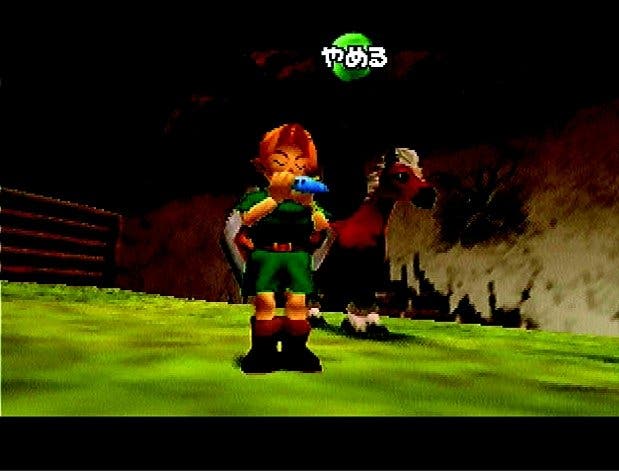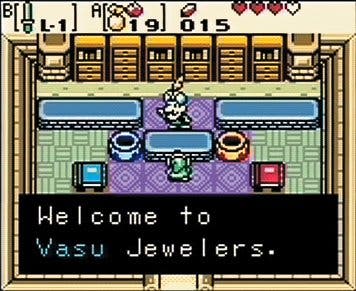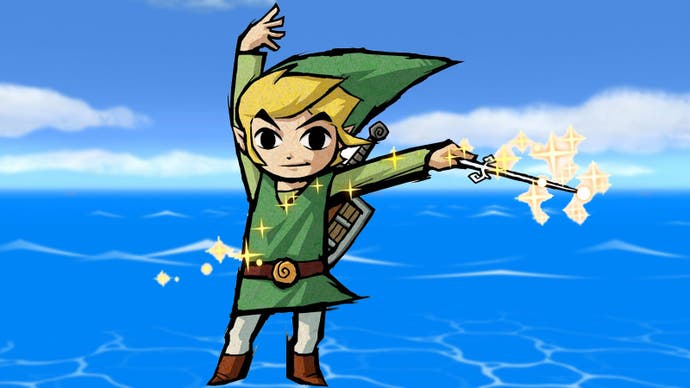The History of Zelda - Part 2
Gratuitous Linkage.
A brief word of warning: Anyone who hasn't played Wind Waker yet (where have you been?) should be aware that there are rather hefty spoilers nestled in the first and last paragraphs. If you don't want the ending ruined for you, you might want to avoid it. And another brief word: Looking for part one? Da-da-Da-DAAAH!
The Legend of Zelda: Majora's Mask, 2000
"He embarked upon a secret and personal journey..."
Majora's Mask was burdened with what is quite possibly the most difficult task that any videogame has ever had to bear: being an adequate successor to Ocarina of Time. So, newly-appointed director Eiji Aonuma did the only sensible thing and sent it in a completely different direction. It is almost certainly intentional that Majora's Mask is so different enough from Ocarina of Time (and, indeed, every other game in the series) as to render direct comparisons somewhat irrelevant.
This beloved anomaly is a much more surreal and even more atmospheric game than Ocarina of Time, and a much darker one too. Where the player is distanced from Hyrule's demise in OoT, trapped for seven years whilst it deteriorates and festers, here the prospect of imminent disaster is all too immediate. The demonic, grimacing moon that looms ever larger over Termina as the game progresses is one of the most affecting and enduring pieces of imagery in videogaming, and the strange alternate world it threatens to destroy is very different from OoT's Hyrule; it's more compact, more alive, and in many respects much more likeable. This is one of the only Zelda games where it is possible to truly engage with the characters, and it is irresistibly tempting to take part in their lives as they go about their perpetual three-day routines. Reuniting mothers, sons, lovers and friends and witnessing the stubborn denial, mad panic or abject terror of Clock Town's citizens in the face (quite literally) of the oncoming disaster, it is difficult to remain distanced from Termina. It is bleak, and unexpectedly beguiling.

Despite this human aspect, Majora's Mask is a lonely game. Link is disorientated and friendless in this surreal world, robbed of his identity by a Skull Kid's malicious trick and forced to relive the same three days over and over as the only one with the ability to prevent the catastrophe. He is pitiable here, slightly vulnerable, much more of a character than he has ever been elsewhere. Majora's Mask begins with him wandering alone in the Lost Woods in search of Navi, his 'beloved and invaluable friend', whom he never finds, and ends as he rides off into the distance whilst the rest of Termina enjoys the Carnival of Time. Majora's Mask is strange and sad, and seemed to signal a change in direction for the Zelda series that, most disappointingly, never really materialised. It was a definite sidestep for the series, and playing it again today, it opens the eyes to just how essentially similar the other games are to each other in comparison. Its strangeness, surreal, angular beauty and uniquely compact, varied gameplay make it stand out as a brave and different entry into Zelda canon. Majora's Mask is a game of tremendous worth, and it's really only now that it is beginning to be fully appreciated, both within the context of the series and without.
The Legend of Zelda: Oracle of Ages/Seasons, 2001
"My sense of time is all out of whack"
It feels wrong to group Oracle of Ages and Oracle of Seasons together without pointing out that the differences between them were not just aesthetic; these are two quite separate games, but played together they become one of the most complex and intelligent titles in the entire series. Each has its own plotline, but completing one yields a password that opens an alternative quest in the other, which in itself has its own separate tale to tell - it revolves around the resurrection of Ganon, and ties up a lot of loose ends following Ocarina of Time. Together, Ages and Seasons form a giant adventure spanning four seasons, two time zones, an awful lot of bonus passwords and about forty hours of play, and the fact that they didn't turn out a confusing, over-complicated mess says a lot for their excellent, concise design. Despite the simplistic graphics and very retro, NES-reminiscent gameplay, Ages and Seasons are among the most ambitious games in an extremely ambitious series.

The story of their development explains a lot about why Ages and Seasons are so curiously reminiscent of the original The Legend of Zelda. Working under Capcom, developer Flagship was originally licensed to produce three games (the Triforce Trilogy), two of them being remakes of the first two games in the Zelda series and the third, a unique creation. When it became apparent that such an effort just wasn't going to work, the Triforce Trilogy became three separate Oracle games, the third of which was eventually cancelled. Oracle of Seasons bears the greatest residual resemblance to TLoZ - it is more action-orientated than Ages, many of its dungeon designs are oddly familiar and it shares six of its bosses with its primitive forebear.
Ages and Seasons have a rather disorientating effect on the player. The strangely retro gameplay, complicated season and time-switching, link-up elements and unusually challenging puzzles all undoubtedly play a part, but there is something more subtly odd about them too - Flagship's new ideas are juxtaposed with a fastidiously loyal transposition of Nintendo's own 2D-Zelda template. They feel at once fresh and old-fashioned, familiar and novel - it almost makes you wish that Nintendo farmed out Zelda spin-off titles to trustworthy second-parties on a more regular basis in order to keep things fresh. Until you remember the frankly terrifying abominations that were Wand of Gamelon and The Faces of Evil, and have to go wash your eyes out with carbolic soap.

